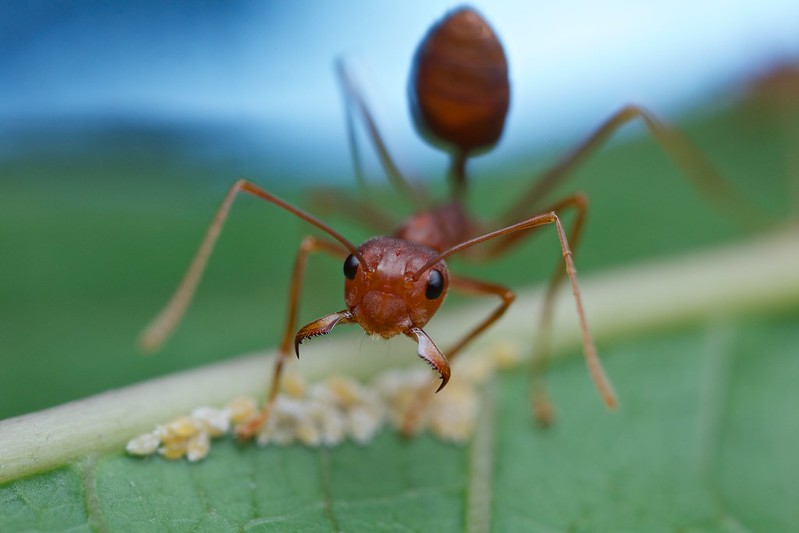The goal of this article is perhaps a little ambitious, but I’d like it to be one of the most comprehensive, factual and well illustrated reference guides for what I have termed the weaver ant complex; a microcosm of predators, prey, and mimics with Oecophylla at its centre. Therefore if you come across any errors, new information or something which I have left out which bears inclusion then please leave a comment to that effect and I will strive to remedy the problem. If you have photos you would like to contribute which demonstrate interesting behaviour or contributes to the ever expanding web of ant-associated organisms you can email me at pbertner@gmail.com. Thank you to all the contributing photographers for their kind permission.
—————————————————————————————————
Part I – An introduction to the Weaver ant (Oecophylla)

Weaver ant (Oecophylla smaragdina) guarding a colony of mealy bugs which it protects in exchange for honeydew, a plant-phloem concentrate rich in sugars. Photo taken in Angkor Wat, Cambodia. Copyright Paul Bertner 2013.
A keystone species is a species which has a disproportionally large effect on its environment relative to its abundance or biomass and whose removal from the ecosystem would constitute a dramatic shift in its composition, the result of a trophic cascade ie. a domino effect in which organisms dependent on the keystone species either:
a) Flourish and come to dominate the environment to the detriment of other species, lowering overall biodiversity Eg. the sea otter (Enhydra lutris), a predator of herbivorous, rapidly reproducing prey (sea urchins).
or b) Perish as a result of the absence of an essential service that the keystone species provided eg. Pollination, resources, etc…
Keystone is a term often applied (sometimes erroneously) to large, dominant predators and flagship species like the wolves of yellowstone or jaguars in the rainforest due not only to their overrepresentation in the media and research, but also due to the more readily measured effects on the ecosystem. However, the term may equally be applied to plants like the fig tree which supports a large number of species with its fruits, or the honeybee, a pollinator without which the angiosperms (and organisms which depend on them) would surely never have enjoyed the same level of success as they have.
While weaver ants don’t follow the classical definition (ie. their abundance/biomass is often greater than that of other species in the community therefore they produce less of a “leveraged effect” than traditional keystone species), they are undoubtedly sculptors of their environments, impacting not only their immediate surroundings, but also its genetic composition over an evolutionary timescale. As a result of their unparalleled level of social cohesion, coordination and communication they have come not only to dominate the majority of environments they inhabit, but also to increase its biodiversity. With respect to the latter, this not only applies to their near-indiscriminate predation and thus control of overly abundant species, but in a fascinating model for co-evolution, a bewildering array of arthropod species have developed remarkable strategies to evade, co-exist, or else deceive the ant super-organism by means of subterfuge. Hence the weaver ant has effectively shaped the genetic destiny of a significant number of arthropod species across a variety of genera. Out of what can often be a barbaric rainforest they have created a kind of savage garden.
Ants are known for their ability to dramatically alter and indeed tame their surroundings. Whether it be the vast swathes of rainforest and grasslands denuded by leafcutter ants (Atta sp.) of the New world, whose farming predates our own by millions of years. Or else the establishment of a fully functional microenvironment within a single tree as in the the raising, feeding and eventual slaughter of armoured scale insects by Melissotarsus sp. Oecophylla’s dominance over the landscape is no less impressive. To the casual observer its abundance is clear, this is especially the case in disturbed forests and agricultural lands where Oecophylla can quickly establish itself and spread throughout the landscape via multiple nests all belonging to the same colony, a behaviour known as polydomous nest building. Within older secondary and primary forests, its dominion, though perhaps less visible as a result of its arboreal habits, is no less of a shaping force. To what then does Oecophylla owe its tremendous success? The answer is manifold and includes morphological (incredible load bearing capability), biochemical (complex chemical signalling ie. pheromones), and behavioural (polydomous nest building) adaptations among many others which are still the focus of ongoing research.
The following segments of this article will attempt to explain the phenomenal success of Oecophylla from the cellular level to the macroscopic to the more integrative natural history. The last of which plays host to a large cast of characters with an amazing variety of strategies to cement their place in the Oecophylla complex. This is a work in progress and very open to suggestions, so please feel free to leave constructive feedback in the comment box or by email.
References
1- Reisewitz SE, Estes JA, Simenstad CA. Indirect food web interactions: sea otters and kelp forest fishes in the Aleutian archipelago. Oecologia: 2006 Jan (4): pp.623-31. Epub: 2005, Sep. 27. http://www.ncbi.nlm.nih.gov/pubmed/16193296
2- Christopher C. Wilmers, Robert L., et al. Trophic facilitation by introduced top predators: grey wolf subsidies to scavengers in Yellowstone National Park. Nov. 2003. Journal of Animal Ecology Vol.72 (6): pp. 909-916. http://onlinelibrary.wiley.com/doi/10.1046/j.1365-2656.2003.00766.x/full
3- Wright SJ, Gompper ME, and Deleon B. Are large predators keystone species in Neotropical forests? The evidence form Barro Colorado Island. 1994, Nov. Oikos: Vol. 71 (2): pp. 279-294. http://www.jstor.org/discover/10.2307/3546277?uid=3739400&uid=2&uid=3737720&uid=4&sid=21103891370077
4- Yang D, Peng Y, et al. Relationship between population variation of fig trees and environment in the tropical rainforests of Xishuangbanna. 2002, Sep. 23. Huan Jing Ke Xue (5): pp. 29-35. http://www.ncbi.nlm.nih.gov/pubmed/12533922.
5- Y.Ben-Dov and B.L. Fisher. The mutualism of Melissotarsus ants and armoured scale insects in Africa and Magadascar: distribution, host plants and biology. Entomologia hellenica 19 (2010): 45-53. http://www.entsoc.gr/volume19b/2010-45-53-Ben-Dov%20and%20Fisher.pdf.
